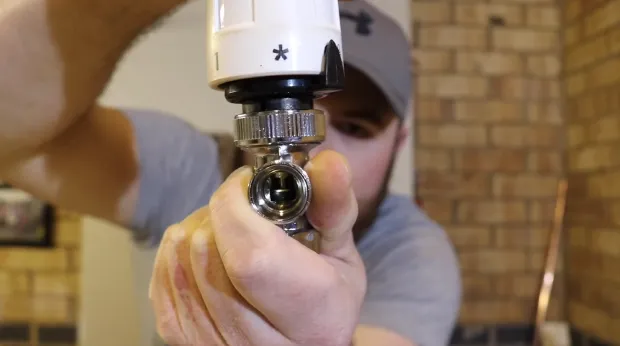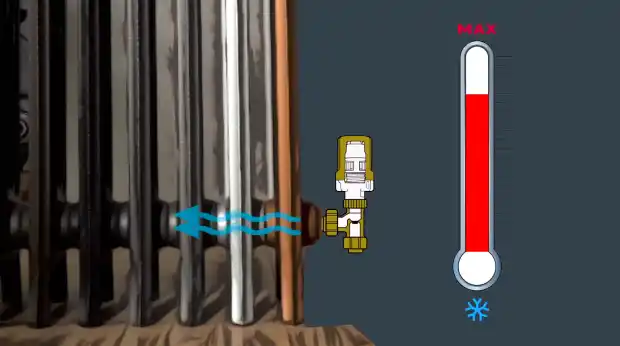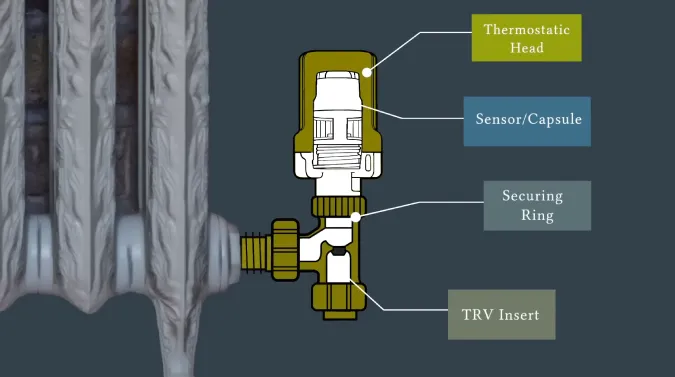Last Updated on May 18, 2023
With no thermostatic radiator valve (TRV), your heating system won’t be as energy efficient because it can’t adjust the temperature between rooms. This will cause empty rooms to be heated at the same temperature as occupied rooms, wasting energy and increasing utility expenses.
If you do not have a thermostatic radiator valve, you may experience drafts and stuffiness in your home. TRVs allow you to set different temperatures for different rooms, which can be very convenient.
That is why you should install thermostatic radiator valves in your room, but you might still be wondering, how do thermostatic radiator valves work actually?
TRVs allow homeowners to reduce their energy consumption and have increased control over the temperature in their homes. Please continue reading to better understand how these thermostatic radiator valves work and how they can be used to conserve energy.
Explanation of How Do Thermostatic Radiator Valves Work?

Thermostatic radiator valves (TRVs) in hydronic heating systems work by sensing the air temperature around the radiator and then opening or closing the water flow accordingly. The hot water heats the radiator metal, which radiates heat into the room. The hotter the water, the more heat is radiated.
On top of the valve body is the thermostatic valve head. A pin in the valve body is adjusted due to the changing room temperature, causing the valve head to expand, thereby opening or closing the valve.
This helps to ensure that each room is kept at a comfortable temperature, and it can also help save energy by preventing overheating rooms that are not in use.
TRVs can create “zones” within a home, allowing different temperatures in different areas. For example, a lower setting could be used in bedrooms at night, while a higher setting could be used in living areas during the day.
Working Procedures for Various Types of Thermostatic Radiator Valves
Based on the design, there are two categories of thermostatic radiator valves:
Wax Capsules
Thermostatic radiator valves with wax capsules work by expanding or contracting with temperature changes. As the temperature rises, the wax expands and pushes a piston which opens the valve and allows more water to flow through the radiator.
Conversely, as the temperature falls, the wax contracts, and the piston closes the valve, reducing the water flow. These TRVs are designed to maintain a comfortable room temperature while saving energy by preventing heat loss.
One advantage of wax capsule TRVs over other types of TRVs is that they are not affected or work by changes in pressure. This means they can be used in systems with high pressure, such as central heating systems.
Wax capsule TRVs are generally less expensive than their liquid counterparts and are easier to install. Still, they need to be more accurate in regulating temperature and can be more challenging to maintain.
Liquid Capsules

As the name suggests, liquid capsule valves are made from a liquid-filled capsule that helps to regulate the flow of water through your radiator. The result is a more even distribution of heat, which can help improve your heating system’s efficiency.
Liquid capsule valves have a glycol-based fluid that works by expanding when heated and contracting when cooled. These valves are more sensitive to changes in temperature and can open and close multiple times throughout the day to maintain a consistent temperature.
One advantage of liquid capsule TRVs is that they have a longer lifespan than wax capsule valves. They are also more accurate and easier to use, but they are more expensive and may take slightly longer to install.
Based on technologies, thermostatic radiator valves can be classified as follows:
Straight Type Automatic Thermostatic Radiator Valve
The automatic straight thermostatic radiator valve is an energy-saving device that works automatically to control the opening and closing of the valve according to the room temperature to realize zone control of heating or cooling, thereby achieving the purpose of energy saving.
The main component of this product is a bimetallic element. When the ambient temperature rises or falls, its deformation degree changes accordingly to push the internal sleeve up and down to open or close the valve stem to realize temperature control.
This product adopts a self-sealing structure design with good sealing performance and no water leakage. It uses high-quality materials and advanced production technology to ensure its safe and reliable operation for a long time.
Programmable Smart Radiator Thermostat Valve
The programmable thermostat smart radiator valves can be programmed to adjust the flow of hot water through your radiators, making it easy to keep your home at a comfortable temperature without wasting energy.
This valve also has a sensor that will work when a room is unoccupied and automatically turn down the heat, which allows you to maintain a comfortable temperature in your home without wasting energy. The thermostat valve also has a built-in timer, so you can program it to turn on and off at specific times.
WiFi Mobile Phone App Control Smart Thermostatic Radiator Valve

The future is here with the WiFi and mobile phone app control smart radiator valve. This amazing device lets you control your home’s heating from your phone, meaning you’ll never have to come home to a cold house again.
You can set schedules, adjust the temperature and even turn the heating off and on remotely. The best part is this smart thermostatic radiator valve is compatible and works with most existing radiator systems, so you won’t need to purchase any new equipment.
What are the Numbers on a Thermostatic Radiator Valve?
The digits on a thermostatic radiator valve (TRV) refer to the different settings that determine how much heat is emitted from the radiator. Typically, seven digits (0, *, 1, 2, 3, 4, 5) are printed on the valve that indicates the minimum, maximum, and target temperatures. Here the ” * ” mark indicates the frost protection zone.
The lowest temperature setting is typically around * to 1, which emits just enough heat to take the chill out of the room without making it too warm. The highest setting is usually around 5, making the room very warm. Depending on your needs, several settings between these two extremes will emit different heat levels.
Which Thermostatic Radiator Valves Number Setting Means Which Temperature?
The thermostatic radiator valves (TRVs) typically have working numbers from 0 to 5 and a star symbol stamped on them. The star symbol represents the frost protection zone. Here is what each number means:
0 – Indicates the thermostatic radiator valve is Off
* – Idle temperature setting, which is 7°C recommended for Frost Protection
1 – Lowest temperature setting, which is 10°C recommended for Staircases and Halls
2 – A moderate temperature setting of 15°C recommended for Bedroom
3 – A comfortable warm temperature of 20°C recommended for the Living Room
4 – A slightly hotter temperature of 25°C recommended for the Bathroom
5 – The hottest setting at 30°C Max Settings for big Utility Room
These working number settings will vary depending on your specific heating system and the temperature tolerances of each room in your home. Generally, you should always adjust the thermostatic radiator valves to the lowest possible setting when leaving the house or going to bed.
What are Recommended Thermostatic Radiator Valve Working Settings Temperatures?
Generally, the recommended working temperature for thermostatic radiator valves is between 2 and 3, although this can vary depending on the manufacturer and the outside temperature, as well as the degree of insulation in the room.
A room with good insulation may only need a low setting of 1 or 2, while a room with poor insulation may require a higher setting of 3 or 4. The user is ultimately responsible for experimenting with different settings to determine which works best for their needs.

How Much Does a Thermostatic Radiator Valve Cost?
There are several types of thermostatic radiator valves (TRVs) on the market, and the cost can vary depending on the features and brand. Automatic standard TRVs are the most basic model and typically cost between $10 and $25.
Programmable smart TRVs are the next step in terms of features and cost between $40 and $70. These valves allow you to set a schedule so that the radiator only runs when needed, and you can control them remotely via a smartphone app.
Some wireless TRVs use radiofrequency signals to communicate with a central controller, costing upwards of $100. But, most wireless TRVs are not compatible with all radiators, which is why you should verify compatibility before purchasing.
Check out our list if you’re looking for affordable thermostatic radiator valves. Here you will find a wide variety of thermostatic radiator valves that will meet your requirements.
Can You Put Thermostatic Valves on Old Radiators?
While most people think they can only install a thermostatic valve on a new radiator, this is not the case. Regardless of age, almost any radiator can be equipped and works with a thermostatic valve. The main thing to remember is that the piping connected to the radiator must be in good condition.
You must replace the entire piping system before installing the valve if leaks or corrosion occur. Before installing the valve, you should also ensure that the radiator has been properly bled. The radiator may be unable to heat appropriately if air pockets have formed.
Are There Any Thermostatic Radiator Valves Problems?
Although thermostatic radiator valves (TRVs) are built to last, a few potential problems can arise. One common issue is when the head of the valve begins to stick or catch. This can usually be solved by simply replacing the TRV head.
Another potential problem is when the thermostat itself fails. This will require replacing the entire valve, but fortunately, TRVs are relatively inexpensive. Overall, TRVs are very reliable and will provide years of trouble-free operation.
Do Thermostatic Radiator Valves Shut Off Automatically?
Most radiator thermostatic valves will have a knob that needs to be turned to the left to increase the flow of hot water and raise the temperature. The further you turn the knob, the hotter it will get.
To cool the room down, turn the knob to the right until you reach the desired temperature. Upon reaching the desired temperature, the hot water will automatically cease to flow, and your radiator will shut off. These valves keep the temperature consistent automatically.
How to Keep Your Thermostatic Radiator Valves Working Properly?
TRVs sense the temperature in a room and adjust the hot water flow to the radiator accordingly. These valves are an invaluable part of any heating system and must keep working correctly. Here are a few tips:
● Make sure that the valves are installed correctly. If they do not fit properly, they may not work properly.
● Ensure that the sensing element of your TRVs is regularly cleaned by dusting or wiping them down.
● Keep pets and their beds away from TRVs since their body heat may interfere with the sensor.
● Avoid placing furniture in front of TRVs, as this can obstruct airflow and cause the sensor to malfunction.
● Try leveling your thermostatic radiator valve if it is tilted. TRVs work best when they are horizontal.
Your TRVs can last longer if you follow these simple tips, which can also ensure that your home remains comfortable in every season.


